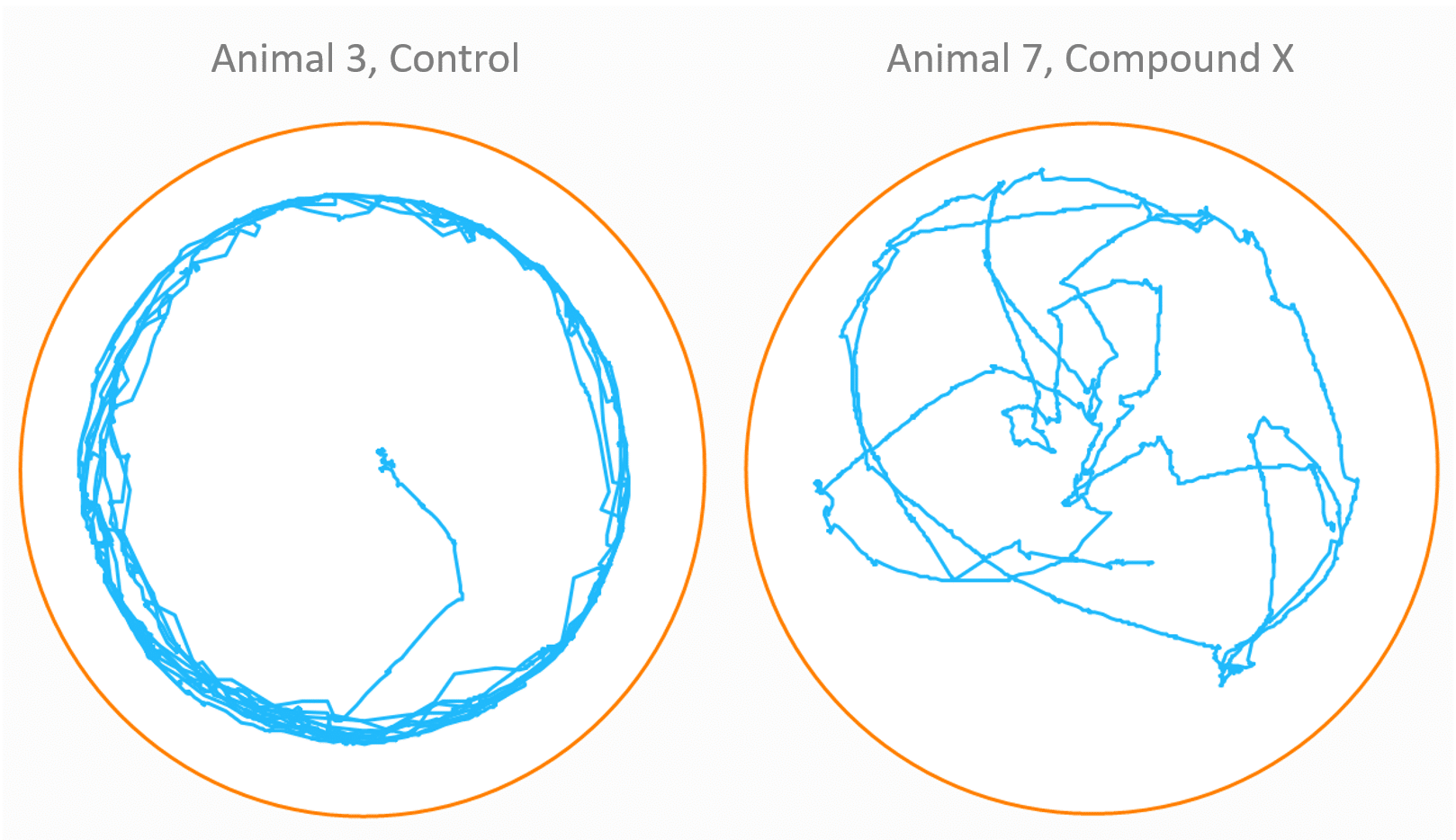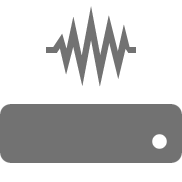To automate Zebrafish experiments, you need reliable tracking and a robust set of tools for analysis
ANY-maze can track both zebrafish larvae and adults and provides hundreds of results including distance travelled, speed, mobility, time in zones, etc.
Use the tabs below to learn more. We've included some videos of real zebrafish tests, so you can see the system in action, as well as details of recommended equipment, such as suitable cameras, and a list of results that are especially useful in this test.

Track multiple animals simultaneously
Increase your throughput by tracking in up to 48 apparatus simultaneously, either live or from pre-recorded videos. This is especially valuable when using multi-well plates.
Tests in each apparatus can be run independently, or you can choose to start or stop test in all apparatus at once.

Analyse behaviour in different zones
In ANY-maze you define zones that are specific to how you want to perform tests in your apparatus – nothing’s prescribed.
For example, in the apparatus shown here, zones have been set up to score how much time the animal spends in the perimeter vs. the centre.
In fact, for every zone ANY-maze reports more than 60 different measures, so you’ll learn much more than just how long the animal spent in each location. And best of all, you can add, edit or remove zones at any time, even after tests have been performed, without needing to retrack the tests.

Follow an intuitive test schedule
ANY-maze automatically maintains a schedule showing the status of all the tests in your experiment.
Break an experiment into multiple stages containing repeated trials – for example, Pre-treatment and Post-treatment.
The schedule is flexible – select the order, skip tests, retire animals, or just add tests as you go along.

View the animal's track
ANY-maze makes it easy to view track plots (or heat maps) of tests for a qualitative assessment of behaviour.
Plots can be tailored to your requirements, perhaps to show just a certain part of the test, or to highlight sections where the animal was moving quickly.
Track plots can be exported for presentation, either as bitmap or vector images, or as videos.

Easily analyse results
You can perform statistical analysis and generate graphs directly from within ANY-maze. As shown in the image to the right, you can also analyse data across time, or choose a custom time period for analysis – you’re not restricted to evaluate only the full test duration.
And as you perform more tests, these analysis tools will update in real time so you can quickly assess how your experiment is progressing.

Results
ANY-maze can provide hundreds of results for any test, but some that are particularly useful in zebrafish experiments include:
- Total distance travelled
- Average speed
- Number of zone entries
- Time spent in a zone
- Latency to enter a zone
- Distance travelled in a zone
- Time spent mobile
- Time spent moving faster (or slower) than a certain speed
Tracking larvae in a 6-well plate
In this video, ANY-maze is tracking six zebrafish larva in a multi-well plate.
Each well has been divided into a centre and perimeter zone, with the centre zone being highlighted when the animal is in it.
ANY-maze can track in as many as 48 apparatus simultaneously.
Cameras
USB Camera
The ANY-maze USB camera is an excellent choice for tracking zebrafish adults or larvae. We recommend fitting this camera with a varifocal (zoom) lens, so you can zoom in and out until the tank or well plate nicely fits the camera's view.
Learn more
Web cam
A webcam provides an inexpensive alternative to the ANY-maze camera. If you intend to test in normal lighting conditions (>= 100 lux), then a webcam should work well.

Muduli, N., et al (2023). Saffron stigma extract and crocin play an important neuroprotective role in therapeutic measures against benzo[a]pyrene-induced behavioral alterations in zebrafish. Drug and Chemical Toxicology, 47(1), 131-142.
Kaur, K., et al (2023). Glabridin mitigates TiO2NP induced cognitive deficit in adult zebrafish. Neurochemistry International, 169, 105585.
Aparna, S. and Patri, M. (2023). Lactobacillus rhamnosus GG treatment potentiates ethanol-induced behavioral changes through modulation of intestinal epithelium in Danio rerio. International Microbiology, 26, 551-561.
Jorge, S., et al (2023). Housing conditions affect adult zebrafish (Danio rerio) behavior but not their physiological status. Animals, 13(6), 1120.
Tamagno, W. A., et al (2023). Household based-pyrethroids on adult zebrafish (Danio rerio) exert behavioral and cholinergic changes in different brain regions. NeuroToxicology, 96, 19-27.
Sarangi, P., et al (2023). Di-2-ethylhexyl phthalate-induced neurobehavioural transformation is associated with altered glutathione biosynthesis and neurodegeneration in zebrafish brain. Fish Physiology and Biochemistry, 49, 501-514.
Santos, N., et al (2023). Effects of environmental concentrations of caffeine on adult zebrafish behaviour: a short-term exposure scenario. Environmental Science and Pollution Research, 30, 63776-63787.
Alef, R. and Blaser, R. E. (2023). Social group during housing and testing modulates the effect of ethanol on zebrafish (Danio rerio) behavior. Behavioural Processes, 209, 104877.
Alves, C., et al (2023). Cannabis sativa-based oils against aluminum-induced neurotoxicity. Scientific Reports, 13, 9813.
Resmim, C. M., et al (2023). Assessing the exploratory profile of two zebrafish populations: Influence of anxiety-like phenotypes and independent trials on homebase-related parameters and exploration. Behavioural Processes, 210, 104912.
Tamagno, W. A., et al (2022). Neuroprotective and antioxidant effects of pitaya fruit on Cu-induced stress in adult zebrafish. J. Food Biochem., 46(7).
Adedara, I. A., et al (2022). Induction of aggression and anxiety-like responses by perfluorooctanoic acid is accompanied by modulation of cholinergic- and purinergic signaling-related parameters in adult zebrafish. Ecotoxicology and Environmental Safety, 239(1), 113635.
Marcon, M., et al (2022). What do male and female zebrafish prefer? Directional and colour preference in maze tasks. European Journal of Neuroscience, 56(5), 4546-4557.
Kaur, K., et al (2022). AlCl3 induced learning and memory deficit in zebrafish. NeuroToxicology, 92, 67-76.
Borba, J. V., et al (2022). Influence of acute and unpredictable chronic stress on spatio-temporal dynamics of exploratory activity in zebrafish with emphasis on homebase-related behaviors. Behavioural Brain Research, 435, 114034.
Pradhan, L. K., et al (2022). Suppression of Chronic Unpredictable Stress-Persuaded Increased Monoamine Oxidase Activity by Taurine Promotes Significant Neuroprotection in Zebrafish Brain. Neurochemical Research, 48, 82-95.
Valadas, J., et al (2022). Ochratoxin A induces locomotor impairment and oxidative imbalance in adult zebrafish. Environmental Science and Pollution Research, 30, 21144-21155.
Fortuna, M., et al (2022). Exposure to levonorgestrel-based birth control pill in early life and its persistent effects in zebrafish. Environmental Toxicology and Pharmacology, 96, 104006.
Valu, M.-V., et al (2021). Effects of the Hydroethanolic Extract of Lycopodium selago L. on Scopolamine-Induced Memory Deficits in Zebrafish. Pharmaceuticals, 14, 568.
Garbinato, C., et al (2021). Investigation on the Anticonvulsant Potential of Luteolin and Micronized Luteolin in Adult Zebrafish (Danio rerio). Neurochemical Research, 46, 3025-3034.
Sahoo, P., et al (2021). Chronic bisphenol A exposure induces temporal neurobehavioral transformation and augmented chromatin condensation in the periventricular gray zone of zebrafish brain. Drug and Chemical Toxicology, 45(6), 2794-2803.
Dumitru, G. et al (2019). Agathisflavone isolated from Schinus polygamus (Cav.) Cabrera leaves prevents scopolamine-induced memory impairment and brain oxidative stress in zebrafish (Danio rerio). Phytomedicine, 58, 152889.
Todirascu-Ciornea, E. et al (2019). Schinus terebinthifolius essential oil attenuates scopolamine-induced memory deficits via cholinergic modulation and antioxidant properties in a zebrafish model. Evidence-Based Complementary and Alternative Medicine, 2019.

 Setting up apparatus
Setting up apparatus Video capture & tracking
Video capture & tracking Observing behaviour
Observing behaviour Connecting equipment
Connecting equipment Automating complex tests
Automating complex tests Running tests
Running tests Results
Results Visualising data
Visualising data Analysis
Analysis Transferring data
Transferring data Open field
Open field Water-maze
Water-maze Y-maze
Y-maze Fear conditioning
Fear conditioning Novel object
Novel object Barnes maze
Barnes maze Radial arm maze
Radial arm maze Light/dark box
Light/dark box Operant conditioning
Operant conditioning Zebrafish
Zebrafish Computers
Computers Multifunction remote
Multifunction remote Accessories
Accessories Digital interface
Digital interface Optogenetic interface
Optogenetic interface Synchronisation interface
Synchronisation interface Relay interface
Relay interface Audio interface
Audio interface Touch interface
Touch interface Analogue interface
Analogue interface USB TTL cable
USB TTL cable Animal shocker
Animal shocker Components
Components Place preference
Place preference ANY-box
ANY-box T-maze
T-maze Zero maze
Zero maze Hole board
Hole board Sociability cage
Sociability cage OPAD
OPAD RAPC
RAPC Waterwheel forced swim test
Waterwheel forced swim test Thermal gradient ring
Thermal gradient ring Operon
Operon Activity Wheel
Activity Wheel Full ANY-maze licence
Full ANY-maze licence Other licence types
Other licence types Developing countries licence
Developing countries licence Contact support
Contact support Support Policy
Support Policy FAQs
FAQs Guides
Guides Downloads
Downloads Send us files
Send us files Activate a licence ID
Activate a licence ID Contact us
Contact us Blog
Blog About
About Testimonials
Testimonials Privacy Policy
Privacy Policy
